
In the languid bends of the Holy Ganga, where the river slows to cradle Patna in its muddy embrace, sits Sadaqat Ashram - an institution that looks less like a fortress of politics and more like a patient listener of time. The ashram's sprawling 20 acres, low-slung buildings, shaded courtyards, and modest verandahs have witnessed the unfolding of the Indian story in gestures both monumental and mundane. In 1940, this quiet sanctuary briefly became the heartbeat of a nation. Mahatma Gandhi arrived, his presence barefoot and ascetic; Jawaharlal Nehru, restless with the impatience of youth and modernity; Rajendra Prasad, steady as the soil of Bihar itself. The Congress Working Committee met here, debating not merely strategies but destinies, at a time when freedom was still a dream straining against the bars of the British colonial empire. The Sadaqat Ashram gave birth to the "Idea of India."
Sadaqat means truthfulness, honesty in Urdu
To take a trip down memory lane, the Sadaqat Ashram (the word Sadaqat, in Urdu, means truthfulness, honesty and integrity), in Patna, was built by Maulana Mazharul Haque in July 1921, on land donated by his associate, Khairun Miyan, as a centre for the freedom movement. Named for its intended purpose of providing "an honest refuge", the ashram served as a home and meeting place for prominent leaders like Mahatma Gandhi, Pandit Jawaharlal Nehru, Dr Rajendra Prasad (the Ashram became his home during his last years), Maulana Abdul Kalam Azad, JB Kripalani, Anugrah Narayan Sinha and Jayaprakash Narayan. It was established as a base for the national movement and a school for students boycotting official universities. The Ashram houses the headquarters of the Bihar Vidyapeeth, a national university. The Kamala Nehru Balika High School and Kamala Nehru Shishu Vihar School are also located on the campus of the Bihar Vidyapeeth, providing education to disadvantaged children. The ashram features the Rajendra Smriti Sangrahalaya museum, which exhibits Rajendra Prasad's personal belongings.
Eighty-five years after the historic 1940 CWC meeting, the ashram is once more being dusted, decorated, and prepared for another gathering of the same committee, though it now presides over a Congress very different in stature and spirit. Party leaders invoke the phrase "India's second freedom struggle," and speak of Bihar as "the political centre of India." Their rhetoric is grand, their banners insistent. But one feels the weight of the contrast. In 1940, Congress was the nation's pulse; today, it is a faint heartbeat in Bihar, trailing in single digits in the assembly it once dominated.
Past as a matter of destiny, present simple arithmetic
The irony is palpable. Where once the walls heard the clang of freedom's anvil, now they echo with the more brittle clang of slogans. In Mahatma Gandhi's day, the Congress spoke for millions who had nothing but hope as their weapon. In today's Patna, the Congress speaks of alliances, seat-sharing, survival - the vocabulary of a diminished force. The past was a matter of destiny; the present, of arithmetic.
Yet to dismiss the pageantry as hollow would be to miss something essential about Indian politics, which thrives on the grammar of memory. By returning to Sadaqat Ashram, the Congress seeks to borrow gravitas, to stand in the shadow of giants, and to suggest that the struggle is not over - that freedom must be defended anew, whether against foreign rule then or majoritarian dominance of the ruling NDA now. History, in this telling, is less a record than a reservoir, a well into which slogans can be dipped for legitimacy.
Congress must remake the party before remaking the Nation
Still, the visitor to Sadaqat Ashram feels the dissonance. The neem trees, the crumbling walls, the air heavy with river mist, remind us that history does not repeat so much as it rhymes faintly. Mahatma Gandhi's India was unmade and remade in these spaces; today's Congress must first remake itself before it can claim to remake the nation.
Patna, once the crucible of revolution, now hosts a party struggling for relevance. The Congress of the 1940s could afford to debate the pace of freedom, the template of the idea of India; the Congress of 2025 must debate whether it can even find its footing. And so Sadaqat Ashram becomes both stage and metaphor - an ashram where freedom once took breath, and where now rhetoric tries to summon ghosts.
The question lingers in the misty courtyards: is this a rebirth, or merely a remembrance? In the stillness of Patna's autumn, it is hard to tell whether history is about to be written again, or whether it is simply being rehearsed.

Movement versus Memory
The table makes plain what the ashram's walls silently register: that Congress in 1940 was a movement carrying a nation on its shoulders, while in 2025 it is a party leaning on memory to steady its own steps.
Then, the leaders spoke of sacrifice because power was still a dream; now, they speak of struggle because power has become a memory. The invocation of a "second freedom struggle" as spelt out by Krishna Allavaru, the Congress Party in charge in Bihar, underscores both the ambition and the irony of today's Congress-it seeks to revive itself by borrowing the aura of its past. But Bihar's electorate, more pragmatic than nostalgic, will weigh not the echoes of Maharma Gandhi's sandals in Patna's dust but the credibility of Congress's present offer. Sadaqat Ashram thus serves as both shrine and mirror: a place where history was once made, and where, in 2025, the question is whether history can be remade-or only remembered.

Track Latest News Live on NDTV.com and get news updates from India and around the world

